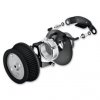As is often the case, I come here for new eyes on a problem and am rewarded. Thanks. Your comments prompted me to go down the rabbithole to try to separate fact from fiction and here’s what I’ve come to believe. After reviewing way too many “information” sources, two sources may be of interest to others.
The first is Harley Davidson’s own breather assembly patent application published in 2002 (
http://www.google.com/patents/US6345613). The second is a detailed explanation and analysis of crankcase ventilation, blowby, and oil carry over by an engineer (
www.106rallye.co.uk/members/dynofiend/breathersystems.pdf). Of particular interest to me was the
large volume of gas vented from an engine crankcase and the complexity of closed (internal) venting systems because of pressure differentials created by nonproportional changes in volumes of blowby and air intake into the throttle body/carb at different operating speeds and engine loads.
I was surprised at just how much blowby there is. Regarding the volume of blowby gas, a first-order calculation of blowby for an 88 cc engine at 3000 rpms is ~40 liters/minute, assuming a highend estimate that blowby volume is 3% of air intake (with a range 0.5-4%). Now going down the rabbithole, I was surprised to learn that the blowby rate
decreases with increasing engine speed and load (cylinder pressure). Rings tend to seal better with increasing rpms and cylinder pressure. The result is that the blowby rate (not volume) is greatest at low speed (rpm) and low load (cylinder pressure). Since blowby volume is a very small percentage of air intake volume (0.5-4%) and is directly related engine speed, the net result is that although blowby volume increases with rpms, it does so less than you’d expect. For example, instead of going from 30 to 50 liters/min when rpms increase from 1000 to 3000, it goes from 30 to say 40 because of the effect of engine speed on ring sealing efficiency. I know, egghead stuff. Don’t read it if it hurts.
Regarding the complexity of closed venting systems, ouch, now my head hurts. Suffice it to say that fixes (like the PCV valve) had to be created to ensure that the direction of flow of vented gases was maintained under different operating conditions.
A couple of consequences of this information caught my attention, and I think some of this relates to Dolt’s points. Because of the large volume of blowby, oil separation from blowby gases becomes particularly important to minimize oil carry over into the combustion chamber. The author of the second article uses a reference of 1 gm of oil per hour as the amount of oil carry over a “world class” engine would have.
By his description this is the amount of oil that would be captured if oil catch cans were connected to the two breather hoses. You might roughly interpret this as saying that if your harley slobber is less than a ml/hr, you haven’t got an unreasonable amount of oil carry over. I see a drop or two of oil on my camcase cover about every 5-10 times I ride. I also see some evidence of slobber on my rear cylinder exhaust pipe heat shield at times that is probably blown back from the air cleaner. I typically ride ~1-2 hrs at a time. Although I can’t say exactly how much oil carry over I have, I’m thinking it isn’t very much. So you might conclude from this that modifying the internal (closed) crankcase ventilation system is reasonable.
An alternative, and I think perfectly reasonable, approach would be to say that if your bike will pass inspection with an external (open) crankcase ventilation system, you should just do it. That way you keep blowby products out of the combustion chamber and everything else upstream in the carburetion system.
A couple of points made by Dolt were reinforced by my trip. Sendin blowby products to the combustion chamber is a compromise. I couldn’t find any scientific evidence of a detrimental effect of closed venting of blowby in terms of interval to ring/valve replacement, but the sniff test says if you don’t have to put those products back in the combustion chamber, just burn the clean stuff. Meaning vent to atmosphere. The second is that for a closed crankcase ventilation system, oil separation is important and the breather assembly is one of harley’s designs to accomplish that, so it should be workin properly for the stock crankcase ventilation system. A rabbithole for another time is how and when to test it.
I think I’ll just leave it at that. For those interested, I’ll provide some followup, probably this summer or fall after many different riding conditions and a few thousand miles.








